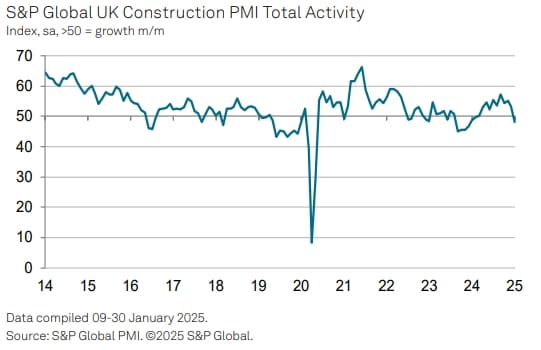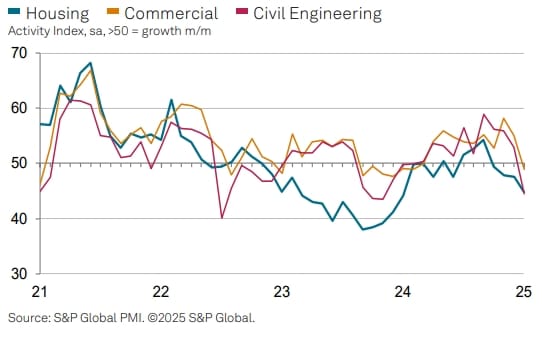The new S&P Global index shows that all categories of construction saw an output reduction in January
The dip in business activity reflected in the February construction PMIs is the first dip in almost a year, since February 2024.
Cost inflation has also been boosted to its highest in 21 months.
Construction activity has dropped for the first time in 10 months
UK construction has dropped from 53.3 in December to 48.1 in January, with house building dropping to 44.9, its fastest decline since January last year, civil engineering declining to 44.6 and commercial construction dropping to 48.9.
The reasons given for the decline in all aspects include a drop in new orders due to client uncertainty, a continued rise in input costs thanks to higher energy, transport, and wage costs for suppliers, and a decline in vendor performance due to shipping delays.
All this has led to the lowest point for business optimism since October 2023.

Tim Moore, economics director at S&P Global Market Intelligence, said: “UK construction output fell for the first time in nearly a year as gloomy economic prospects, elevated borrowing costs and weak client confidence resulted in subdued
workloads.
“Output levels decreased across the board in January, with particularly sharp reductions seen in the residential and civil engineering categories.
“Construction firms noted the fastest fall in residential work for 12 months as market conditions remained somewhat subdued. Anecdotal evidence suggested that caution regarding demand for new projects was prevalent at the start of 2025, despite strong policy support for house building and hopes for a longer-term boost to supply via planning reform.
“The forward-looking survey indicators were also relatively downbeat in January. New orders decreased at the fastest pace since November 2023 amid many reports of delayed decision-making by clients. Reduced workloads, combined with concerns about the general UK economic outlook, led to a dip in business activity expectations to the lowest for 15 months.
“There was little respite on the supply front, as transport delays meant that vendor lead times lengthened to the greatest extent for two years. Demand for construction items softened again in January, but purchase price inflation was the highest since April 2023 as suppliers sought to pass on rising energy, fuel and wage costs.”
Industry reacts to February construction PMIs

Max Jones, director of Lloyds’ infrastructure and construction team, said: “Despite this month’s fall, and ongoing challenges such as persistent inflation and supply constraints, anecdotal evidence suggests businesses remain buoyant and optimistic about the potential for future growth.”
Lauren Pamma, head of energy & infrastructure at Aldermore Bank, said: “After the loss of momentum for construction output growth seen in December, it’s continued into January, with all three of the main categories – residential, civil engineering and commercial construction – for activity seeing weaker performances. However, there is hope on the horizon following the lower-than-expected inflation figures reported last month, which means we may see the base rate start to decline, potentially from today. This could help to reduce slightly elevated borrowing costs and increase demand for new projects.
“Ultimately, there are signs that this year may be better than 2024, but it’ll take time to build up to continued growth. The Government’s investment in infrastructure and commitment to increasing housebuilding targets will benefit the industry, but the ongoing uncertainty around cross-border tariffs could disrupt supply chains moving forwards.
“Countries avoiding US tariffs and reallocating goods to other markets could in turn, negatively impact competing British goods in these markets. We know from our research that nearly seven in 10 (68%) construction SMEs have experienced supply chain delays over the last 12 months, and this figure may well increase in future. The outlook is currently unclear, and SMEs will be monitoring the geopolitical landscape to see what the full impact on the construction sector will be.”














